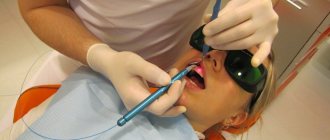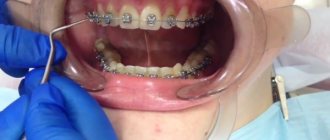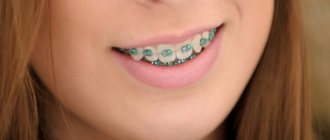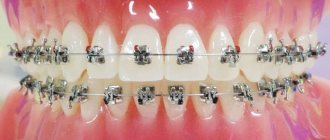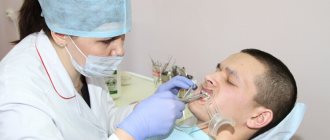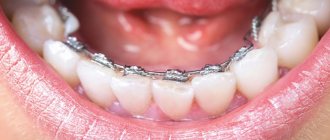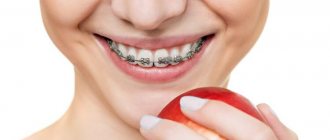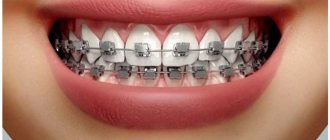27.11.2019
Patients often turn to dentists with malocclusions. To correct it, various methods are used, among which braces are especially popular. The question immediately arises: what is the name of the doctor who puts on braces? This is done by a specialist in a narrow field - an orthodontist, whose activities are very diverse.
Which doctor installs braces?
The procedure for installing braces is the responsibility of an orthodontist. It helps restore a person’s attractive and beautiful smile. Not every dental clinic has such specialists. Therefore, if he is not on the hospital staff, treatment can be carried out by an ordinary dentist who has undergone specialized training.
The need for specialists in this area has arisen relatively recently. Previously, dental therapists were involved in the treatment of dental defects. It was not always possible to obtain the desired result. Therefore, the need for retraining arose. Today, a specialist called an orthodontist treats not only problems with crooked teeth, but also other dental diseases.
The effectiveness of correcting malocclusion primarily depends on the qualifications of the doctor, the quality of the material and equipment used. It is important that he makes the correct diagnosis and identifies the cause of the curvature of the dentition. Only in this case can you choose the necessary design that will help correct the bite.
Braces are placed not only on young people, but also on older people. For the latter category of people, it is very important to find an experienced doctor who installs braces. He must carefully select the design and determine the treatment regimen: duration of wearing braces, frequency of visits to tighten the arch of braces. If the choice of a specialist is made incorrectly, then you should not count on a highly effective result.
It is very important that the doctor who installs braces has not only professional, but also personal qualities. He must be sociable, personable, and also partly a psychologist. All this together will help to select the optimal treatment regimen for a person with dental defects.
What is the name of the doctor who puts on braces, what is the peculiarity of his work?
Patients often turn to dentists with malocclusions. To correct it, various methods are used, among which braces are especially popular. The question immediately arises: what is the name of the doctor who puts on braces? This is done by a specialist in a narrow field - an orthodontist, whose activities are very diverse.
Which doctor installs braces?
The procedure for installing braces is the responsibility of an orthodontist. It helps restore a person’s attractive and beautiful smile. Not every dental clinic has such specialists. Therefore, if he is not on the hospital staff, treatment can be carried out by an ordinary dentist who has undergone specialized training.
The need for specialists in this area has arisen relatively recently. Previously, dental therapists were involved in the treatment of dental defects.
It was not always possible to obtain the desired result. Therefore, the need for retraining arose.
Today, a specialist called an orthodontist treats not only problems with crooked teeth, but also other dental diseases.
The effectiveness of correcting malocclusion primarily depends on the qualifications of the doctor, the quality of the material and equipment used. It is important that he makes the correct diagnosis and identifies the cause of the curvature of the dentition. Only in this case can you choose the necessary design that will help correct the bite.
Braces are placed not only on young people, but also on older people. For the latter category of people, it is very important to find an experienced doctor who installs braces.
He must carefully select the design and determine the treatment regimen: duration of wearing braces, frequency of visits to tighten the arch of braces.
If the choice of a specialist is made incorrectly, then you should not count on a highly effective result.
It is very important that the doctor who installs braces has not only professional, but also personal qualities. He must be sociable, personable, and also partly a psychologist. All this together will help to select the optimal treatment regimen for a person with dental defects.
Orthodontist appointment
A visit to the doctor to install braces includes the following steps:
- external examination of the patient’s oral cavity, identifying orthodontic problems;
- determination of a suitable structure for correction, its material and size;
- installation of a bracket system;
- periodic visits to a doctor called an orthodontist to tighten the main arch.
The specialist must determine the cause of the curvature of the dentition. The most common reasons are:
- bad heredity . Curvature of teeth can be transmitted from parents to children, and this pathology is accompanied by other dental abnormalities (diastema, trema, etc.). In such situations, braces are installed and the identified diseases are treated;
- disorders of intrauterine development . In this case, the child will experience defects as soon as the baby teeth erupt. This category of patients needs the painstaking work of a special doctor called an orthodontist;
- anomalies that develop after the replacement of milk teeth with permanent ones. It is better to consult a doctor in the early stages of deformation processes, this increases the effectiveness of bracket correction.
On average, a doctor installs braces on 15 patients per day. One appointment takes no more than 30-40 minutes and there is no need for additional treatment.
Correcting a bite with braces takes place in 2 stages:
At the first stage, the doctor selects the correct design and carefully installs it for the patient.
At the next stage, retainers or mouth guards are installed, which help consolidate the result. How long to wear them is determined by a doctor called an orthodontist. Such structures have to be used throughout life; this helps to maintain the effect obtained from treatment with braces.
Thus, the treatment of problems with malocclusion is not carried out by a regular dentist, but by a doctor called an orthodontist. His qualifications directly determine how attractive a person’s smile will become.
Reasons for visiting an orthodontist
You should consult a doctor called an orthodontist (he is the one who installs braces) in the following cases: violations of the aesthetics of the dentition, complications that arose after the prosthetic procedure or damage to the soft tissues of the oral cavity, malocclusion, frequent thumb sucking, speech disorders, twisted teeth, incorrect position of the upper or lower jaw.
A timely visit to a doctor will help in many cases to avoid prosthetics and eliminate the reasons that prevent this procedure.
The main stages of the work of an orthodontist
An examination by a doctor called an orthodontist includes the following steps:
- external examination, which allows you to determine the correct position of the patient’s teeth, jaw and possible deviations from the norm;
- X-ray diagnostics, with the help of which the doctor determines the degree of curvature of the dentition and the need to install braces;
- formation of plaster casts, from which an individual design will be made in the future. This is an important stage that requires increased attention from the doctor. If you make the slightest mistake in the calculations, the installation of braces will be ineffective.
After taking plaster casts, the doctor talks with the patient and determines the material for making braces (metal, ceramics, etc.). Before installing orthodontic systems, it is necessary to familiarize the patient with all the advantages and disadvantages of a particular design.
Features of treatment for adults and children
Many parents make mistakes when they do not promptly treat malocclusion in children. Doctors say the earlier the correction begins, the more effective the result will be.
It is considered ideal to see an orthodontist for children as young as 2 years old.
In this case, he will be able to identify possible congenital malocclusions already at the stage of growth of baby teeth (it is by this age that most of the dentition appears in children).
At this age, correction is not done with braces, but with special aligners or mouth guards. Timely implementation of such a procedure helps to avoid many problems in the future.
For adult patients, doctors most often install permanent types of braces, mostly made of metal. They are considered the most durable and effective. When installing such structures, the patient often feels discomfort, so if necessary, the doctor can use anesthesia.
The need to tighten braces
When using this type of bite correction, the teeth move into the correct position . This is a rather long and painful process. The braces are secured using a special arch, which must be periodically tightened as the teeth move. This is also done by an orthodontist who installs the braces system.
How often to tighten the metal arch depends on the degree of curvature of the patient’s teeth and is determined individually. On average, this procedure is performed once every few months; a doctor called an orthodontist will help you determine the exact frequency of visits. This depends on the material from which the braces are made, the condition of the patient’s teeth and the total duration of the course of therapy.
It is not recommended to skip such visits, otherwise the effectiveness of braces will be significantly reduced. On average, correcting a bite takes 3 years or more, so you need to prepare for multiple visits to the doctor.
During braces tightening, a person may experience pain, and you need to be prepared for this.
This process is associated with increased pressure on the teeth as they move. In some cases, doctors may prescribe local pain medications. If the arch is tightened incorrectly, discomfort may occur while talking or eating.
In this case, you must inform the doctor who installed the braces.
Another prerequisite is oral care during treatment with such structures. It involves the use of special toothbrushes, toothpastes and mouth rinses. Your doctor will help you select the necessary medications; he will also explain how to brush your teeth while wearing braces.
Cost of visit
The cost of consulting a doctor who puts braces depends on his qualifications and the type of dental clinic (private or public), the average price ranges from 300-500 rubles. Installation of bracket systems and their maintenance (tightening the arch) is determined individually.
A doctor called an orthodontist corrects the bite and crooked teeth. This is a highly specialized dentist who must have the appropriate qualifications.
The effectiveness of correcting dentition and malocclusion directly depends on its work.
It is best to give preference to trusted clinics and experienced doctors, this will avoid unwanted consequences and help you achieve a beautiful smile.
Source: https://tvoidantist.ru/ortodontiya/brekety/kak-nazyvaetsya-vrach-kotoryj-ustanavlivaet.html
Orthodontist appointment
A visit to the doctor to install braces includes the following steps:
- external examination of the patient’s oral cavity, identifying orthodontic problems;
- determination of a suitable structure for correction, its material and size;
- installation of a bracket system;
- periodic visits to a doctor called an orthodontist to tighten the main arch.
The specialist must determine the cause of the curvature of the dentition. The most common reasons are:
- bad heredity. Curvature of teeth can be transmitted from parents to children, and this pathology is accompanied by other dental abnormalities (diastema, trema, etc.). In such situations, braces are installed and the identified diseases are treated;
- disorders of intrauterine development. In this case, the child will experience defects as soon as the baby teeth erupt. This category of patients needs the painstaking work of a special doctor called an orthodontist;
- anomalies that develop after the replacement of milk teeth with permanent ones. It is better to consult a doctor in the early stages of deformation processes, this increases the effectiveness of bracket correction.
On average, a doctor installs braces on 15 patients per day. One appointment takes no more than 30-40 minutes and there is no need for additional treatment.
Correcting a bite with braces takes place in 2 stages:
At the first stage, the doctor selects the correct design and carefully installs it for the patient.
At the next stage, retainers or mouth guards are installed, which help consolidate the result. How long to wear them is determined by a doctor called an orthodontist. Such structures have to be used throughout life; this helps to maintain the effect obtained from treatment with braces.
Thus, the treatment of problems with malocclusion is not carried out by a regular dentist, but by a doctor called an orthodontist. His qualifications directly determine how attractive a person’s smile will become.
Which doctor puts on braces? How to choose a specialist?
Most people believe that if a bite defect is not noticeable, then there is no need to correct it. Malocclusion (occlusion) is not only an aesthetic problem. Of course, unsightly teeth greatly complicate the communication process. But that's not the main thing.
Occlusion defects cause caries, periodontitis, wedge-shaped defects and problems with the gastrointestinal tract due to disruption of the process of chewing food.
Also, malocclusion may be associated with: disruption of the temporomandibular joint; the appearance of severe headaches, diseases of the ENT organs, poor posture.
Correcting malocclusion involves an entire branch of dentistry—orthodontics. She specializes in studying the causes of abnormalities in the development of incisors and jaws. In addition, he studies how these pathological changes affect the functioning of the human body and develops effective methods for correcting these disorders.
Currently, more and more people are using the services of this branch of dentistry, since it is now possible to correct occlusal defects at any age. Patients are very often not informed which doctor to contact with a similar problem. From this article you will learn about the methods of orthodontic treatment, why and who needs it, and what is the name of the doctor who puts on braces.
Methods for correcting malocclusion
Modern dentistry can correct the most complex cases of occlusion in adults and children.
Bite disorders can be the following:
- hereditary - in this case, malocclusions are often combined with other defects (diastema, trema), they are inherited from relatives;
- congenital - arise during intrauterine development, then as the child grows up, the absence, incorrect position of teeth and other defects of the dentition become obvious;
- acquired – bite defects that arise a long time after birth. If they are recognized in time, then correcting them is not difficult.
Currently, a large number of methods are used to correct occlusal defects and correct the position of teeth. They have different tasks and different costs. Based on the type of malocclusion and the cost of the procedure, doctors can choose a treatment method for almost every patient.
The following methods are used in modern dentistry:
- Lumineers are used for visual correction of small bite defects. There are no other effects on the dentition. The patient gets perfect teeth quickly, without experiencing any discomfort. But complex violations cannot be corrected in this way.
- Veneers are also used mainly for the cosmetic correction of mild malocclusions. But in this case, by grinding the teeth for the installation of veneers, it is possible to make a deeper correction of defects.
- Silicone mouth guards (aligners) are silicone molds that correct a row of teeth, giving it the desired bend and shape. They are used when there is significant curvature of the teeth, but the patient for some reason refuses to install braces.
- Trainers are designed to correct minor malocclusions. They align teeth that are separated from each other well. These designs are worn for only a few hours during the day. They are affordable.
- Braces are a reliable orthodontic system. She copes with the most complex defects. The process of straightening teeth with braces is quite lengthy: it lasts several years. Often these systems look unaesthetic, so some patients still refuse to undergo this type of correction.
Which doctor puts braces?
It is believed that only children and adolescents can correct their bite and misaligned teeth. But modern dentistry is able to correct an adult’s bite. Although you will have to wear the structure longer, since the jaw is already formed.
Braces are a complex system for correcting malocclusion, consisting of separate parts. It consists of brackets connected to each other using a power arc.
The system also includes:
There are different types of braces, depending on the method of attachment to the teeth.
The systems are as follows:
- Vestibular - orthodontic structures attached to the front surface of the tooth. In terms of cost, this is a more affordable option.
- Lingual - those that are attached to the inner surface of the teeth. But there are limitations to their installation, and they are more expensive than the first option.
Patients have a question: who installs braces and other orthodontic systems. A doctor who corrects the position of teeth and bite, installing braces and other systems to correct these problems is called an orthodontist. Today, dentists in this specialty can be found in large private and public dental medical centers.
What else does an orthodontist do?
An orthodontist must have special spiritual qualities, be sociable and pleasant in communication.
He must be able to reassure the patient and instill in him confidence in a favorable outcome of the procedure, since the installation of structures is not always pleasant.
Bite correction using braces is a complex and lengthy process that involves wearing a system that is not always aesthetic. A good specialist always knows how to reassure the client and how to help him in the best possible way.
In what cases can you still consult an orthodontist:
- if there are any defects in the teeth located in the smile area that spoil the aesthetics of the dentition;
- in case of problems arising after prosthetics;
- if there are speech defects associated with the position of the teeth;
- when a person has ruined his bite due to bad habits (pencil or finger sucking);
- with crowded teeth;
- if the jaws are positioned incorrectly;
- in the presence of any secondary malocclusions.
An orthodontist may also be involved in the treatment of gingivitis, periodontal disease, periodontitis, and caries.
Installation steps
Before correcting the bite, the doctor must have a complete picture of the disorder of the dental system. Before installation of the structure begins, the patient undergoes a diagnostic stage, during which it is necessary to determine the severity of the defect and how long it will take to correct it.
Diagnostics includes the following steps;
- The orthodontist performs an external examination. He studies the structural features of teeth and jaws and assesses the severity of the defect.
- X-ray examination of the patient's jaw . On an x-ray you can see what is invisible during an external examination.
- Models of the patient's jaws are made from plaster . The doctor measures all parameters of the jaws and determines what possible deviations are possible in order to take them into account when installing an orthodontic system.
After completing all the diagnostic steps, the specialist determines what method needs to be used to correct the patient’s malocclusion.
Before installing an orthodontic system, all teeth affected by caries and other inflammatory processes in the oral cavity must be cured.
The installation process takes no more than two hours.
- Before installing the structures, the patient's lips are lubricated with Vaseline to prevent them from drying out.
- A tube is inserted into the oral cavity to evacuate saliva. They also use a special device to ensure maximum dryness of the mucous membrane.
- All tooth surfaces are cleaned and thoroughly dried.
- A special glue is placed on the enamel layer of the teeth, which holds the bracket system on them.
- The structural element is pressed firmly to the teeth and the glue is fixed with a light lamp.
- After all elements of the system have already been installed, the doctor secures the arc with reverse traction and cuts it exactly to size so that the patient does not feel any discomfort.
After a few weeks, the person gets used to the structures and no longer feels any discomfort.
When to see a doctor after getting braces?
During the period of dentition correction with braces, the bite is gradually corrected. Wearing the structures can be very long: from six months in mild cases to two years in severe defects.
And in rare cases, they can be worn for up to three years. It is necessary to visit the dentist at least once a month. The doctor monitors the treatment process and makes corrections if necessary.
He also activates the brace system at each visit.
Cost of services
The price of braces varies. It depends on many parameters: on the material from which it is made, on the method of fastening.
For materials
We give the approximate cost of the structure per jaw, depending on the material.
- metal - 30,000 rubles;
- ceramic - 40,000 rubles;
- sapphire - 50,000 rubles;
- sapphire with a white arc - 60,000 rubles;
- lingual structures - up to 100,000 rubles.
However, this cost is not the final price of the entire treatment. All services for installation, activation of the structure and its removal will require additional payment.
To work
Of course, the price for bite correction with braces includes the price of all services and additional methods of treatment and examination.
- cost of preparation for installation. Depending on the complexity and number of diagnostic procedures and manipulations, it can cost from 1,500 to 200,000 rubles;
- installation of structures on each jaw;
- installation of additional system elements;
- each appointment to activate braces;
- production and installation of retainers;
- gluing structures;
- replacement of arches;
- regular professional teeth cleaning;
- removal of the orthodontic system;
- polishing teeth.
The cost of the service may also be affected by the level of the clinic, the complexity of the pathology and the qualifications of the doctor, as well as markups from companies that will supply consumables.
Dentist advice
To avoid complications in the correction of bite with braces and not to prolong the treatment period, it is important to strictly follow the recommendations of orthodontists.
- for the first week after installation, you can only eat soft and liquid foods;
- It is forbidden to eat too cold or hot dishes: temperature changes negatively affect the glue and metal parts of the structure;
- do not eat too hard food: it can damage the system or even tear the structure off the teeth;
- It is forbidden to use toothpaste with a high content of abrasives;
- Viscous and sticky foods are prohibited (crispy potatoes, toffee, bread rolls), they clog the system, and it is not easy to clean it from the remnants of this food;
- it is necessary to purchase a special brush and clean the structure and teeth after each meal;
- every day before going to bed, the systems should be cleaned with special brushes;
- If the braces come off, you need to visit the dentist as soon as possible.
Following these simple recommendations will allow you to achieve good results in correcting occlusion in a timely manner.
Reviews
I decided to install braces on my upper jaw. My incisors are not as crooked as others have, but I wanted my smile to be perfect. Before installing the structures, she underwent diagnostics and treated her teeth from caries. Well, the day finally came when I got braces.
It was unpleasant to sit with your mouth open for 2 hours. But I didn’t feel much pain. When I was driving home, I felt that my teeth were pulling. The doctor who corrected the bite warned that my jaws would hurt.
I took painkillers for three days, then the discomfort went away, but for another two weeks the structure was in my mouth. There were particular difficulties with food: we had to cut all the food finely. It's been 3 months already. I'm used to braces. My incisors have become straighter.
Now I go for routine examinations, the doctor tightens the structure. It's too early to say anything, but I believe that I will have a beautiful smile.
I had crooked incisors on my lower jaw, so I decided to install braces on it. The dentist said that it makes no sense to put it on one jaw, you need to do it on both at once. I had ceramic braces installed.
At first my incisors ached a lot, I took painkillers, but after three days everything went away. For a long time I was bothered by the feeling that the structures were in the way in my mouth. But after that I got used to it too. The pain returned after the next visit to the dentist, when he tightened the braces.
I wore braces for exactly a year. My bite has improved. Now I have a beautiful smile.
I had very crooked teeth on the upper and lower jaw. I wore braces for three years and two months. At first, my teeth ached after the procedure. Then the pain went away, leaving a feeling that the structures were in the way in the mouth.
The pain returned after another visit to the dentist for a tightening. The incisors could not be corrected in any way; some even had to have structures installed on the inside. It was difficult, of course, and took a long time, but the teeth were finally fixed.
Now I have straight incisors and a correct bite. I'm happy with the result.
From this video you will learn why braces are installed and what types of structures there are to correct occlusion.
Source: https://stomatologiya29.ru/ortodontiya/kakoj-vrach-stavit-brekety-kak-vybrat-speczialista
Reasons for visiting an orthodontist
You should consult a doctor called an orthodontist (he is the one who installs braces) in the following cases: violations of the aesthetics of the dentition, complications that arose after the prosthetic procedure or damage to the soft tissues of the oral cavity, malocclusion, frequent thumb sucking, speech disorders, twisted teeth, incorrect position of the upper or lower jaw.
A timely visit to a doctor will help in many cases to avoid prosthetics and eliminate the reasons that prevent this procedure.
When should you contact an orthodontist?
Not all patients know when it is recommended to see an orthodontist. There are a number of signs that should be a signal to go to the doctor who will install braces, namely:
- violation of diction;
- gum inflammation and bleeding;
- painful sensations when opening the mouth;
- abrasion of teeth;
- difficulty biting and chewing food;
- profile change;
- violation of facial symmetry.
These symptoms may serve as signs of the development of pathology, and are a reason to visit a specialist. After examination, the doctor may order additional tests to confirm the accuracy of the diagnosis.
The main stages of the work of an orthodontist
An examination by a doctor called an orthodontist includes the following steps:
- external examination, which allows you to determine the correct position of the patient’s teeth, jaw and possible deviations from the norm;
- X-ray diagnostics, with the help of which the doctor determines the degree of curvature of the dentition and the need to install braces;
- formation of plaster casts, from which an individual design will be made in the future. This is an important stage that requires increased attention from the doctor. If you make the slightest mistake in the calculations, the installation of braces will be ineffective.
After taking plaster casts, the doctor talks with the patient and determines the material for making braces (metal, ceramics, etc.). Before installing orthodontic systems, it is necessary to familiarize the patient with all the advantages and disadvantages of a particular design.
Health problems due to malocclusion
Not many people realize that an orthodontist is also a person who, through treatment, can affect the overall health. The fact is that when the bite is disturbed, a number of very unpleasant and sometimes even dangerous processes begin to occur in the body:
- due to the incorrect location of some teeth, the rest may suffer, because they bear a heavy load, leading to wear and abrasion of the enamel, increased sensitivity, premature destruction,
- with malocclusion, facial asymmetry occurs, the functioning of the temporomandibular joint is disrupted, resulting in headaches, migraines,
- “wrong” teeth can injure the cheeks, lips, tongue, and other mucous membranes. Inflammatory processes cannot be excluded here,
- deterioration in breathing, swallowing and apnea, various speech defects,
- discomfort when chewing food and limited chewing function lead to diseases of the gastrointestinal tract, indigestion, and ulcers.
Incorrect position of teeth
Now do you understand how important it is to contact a specialist on time? An orthodontist is the one who will correct the bite and thereby help get rid of the consequences of a malocclusion - that’s for sure.
Even if you do not experience significant problems with your bite, be sure to visit a doctor. If you have hidden malocclusions, the orthodontist can easily determine this during the first visual examination and prescribe corrective treatment.
We invite you to familiarize yourself with plaque on the tongue in adults: reasons, how to remove it, photos
Features of treatment for adults and children
Many parents make mistakes when they do not promptly treat malocclusion in children. Doctors say the earlier the correction begins, the more effective the result will be.
It is considered ideal to see an orthodontist for children as young as 2 years old. In this case, he will be able to identify possible congenital malocclusions already at the stage of growth of baby teeth (it is by this age that most of the dentition appears in children). At this age, correction is not done with braces, but with special aligners or mouth guards. Timely implementation of such a procedure helps to avoid many problems in the future.
For adult patients, doctors most often install permanent types of braces, mostly made of metal. They are considered the most durable and effective. When installing such structures, the patient often feels discomfort, so if necessary, the doctor can use anesthesia.
What is the name of a braces doctor?
Installing braces is a fairly common procedure in modern dentistry. They are designed to solve problems with bite and are a construction of locks, ligatures and other elements.
Anomalies of teeth
The causes of malocclusion may be the following anomalies:
- anomalies of individual teeth or several (teeth may be rotated, tilted, located in the wrong place or have too much complexion);
- jaw abnormalities (jaw is displaced, protruded, or underdeveloped);
- anomalies of the dentition (teeth are inclined towards the tongue and away from it, there are gaps between the teeth, crowded arrangement of teeth).
Description of structures that can correct the bite
Aligners or mouthguards are structures made of heavy-duty materials.
Advantages of aligners:
- Possibility to remove the structure;
- Made from discreet transparent material;
- Minimal discomfort when wearing;
- There is no need for special care (except for normal hygiene and rinsing with water).
Trainers are structures that are worn for several hours a day, depending on doctor’s orders. They are produced in series, which makes them affordable. Designed to correct minor changes in bite. With their help, it is good to align teeth that are located separately from each other.
Braces are small brackets connected by a power arc. Such designs are capable of correcting a large number of different deviations.
Note: They are worn depending on the initial curvature of the teeth and the body’s adaptation to changes, from two months to five years.
Which doctor puts on braces?
Patients often have a question: what is the name of a braces doctor? Bite anomalies are a field for the work of an orthodontist. Due to the rather narrow specialization of such a specialist, it is not always easy to find him.
The results of correcting the bite primarily depend on who puts the braces on, that is, on the qualifications of the doctor, as well as on the equipment of the dentistry where the treatment is carried out. If the doctor has correctly diagnosed and drawn up the correct correction plan, the patient can already count on successful treatment.
Some people are mistaken in believing that only young patients consult an orthodontist. After all, adults can also get braces. The only thing is that, due to the high density of dental tissue in adults, they will have to wear braces longer than children.
Features of the orthodontist's work
When seeing a patient, the doctor needs to explain to him the purpose of wearing braces and how this will affect changes in the bite. On average, an orthodontist manages to see up to 13 people in one working day. One appointment takes approximately 30 minutes.
Treatment with braces takes place in 2 stages. At the first stage, the doctor makes a diagnosis and installs correction devices. At the next stage, it is secured by installing mouthguards or retainers on the inside of the teeth, which resist displacement of the bite.
For each situation, the doctor needs to choose the appropriate design. Braces differ in the method of fastening, the principle of influence and appearance.
Types of bites can be different. Let's consider the main ones:
- hereditary, passed on from parents to their children. Bite defects in this case are combined with the presence of additional teeth, diastema and trema. When diagnosing, there is a need for additional procedures;
- congenital, when disorders occurred already during the development of the fetus. Then, after birth and adulthood, dental defects or lack thereof are observed. This complex type of bite is a job for an experienced orthodontist;
- acquired, arising years after birth. It can be recognized at an early stage of its appearance, so treatment is more effective and does not take much time.
Today, an orthodontist in cities can be found in both private and city dentistry. Therefore, people with malocclusion can easily be helped by a qualified doctor who can correct defects and make their smile attractive.
An orthodontist who is popular among patients usually has human qualities in addition to professional ones. He is tolerant, sociable, efficient and friendly.
Also, a good orthodontist must be a psychologist in some way. After all, many people have a negative attitude towards braces, the installation of which can cause them stress.
A good doctor knows how to win over a client and help him as much as possible.
An orthodontist is not just a dentist, his work is designed to make teeth beautiful, without causing discomfort, and people happy and smiling.
When should you see a doctor?
Let's consider the cases in which you need to see an orthodontist:
- If there are defects that spoil the aesthetic condition of the smile, the patient can voluntarily consult a doctor.
- In case of disorders of the dentofacial apparatus (for example, complications after prosthetics or tissue damage), a visit to the orthodontist is simply necessary.
- Formation of a deep bite.
- The lower jaw is positioned incorrectly.
- The presence of negative habits (speech deviations, the patient often sucks his finger, etc.).
- Curled teeth.
- Secondary malocclusion.
The services of an orthodontist can eliminate problems that interfere with prosthetics, or make it possible to avoid them.
An orthodontist also treats caries, periodontitis, periodontal disease and gingivitis.
Stages of treatment by an orthodontist
At the beginning of treatment, the specialist conducts a diagnosis, which largely determines the final result.
The patient goes through the following stages:
- Visual inspection. The doctor studies the symmetry of the face, shape, profile and features of the oral cavity. An assessment is made of the general appearance of the teeth and jaws. The movement of the jaw and the closure of teeth are studied. The examination helps to identify how severely the bite is deformed and determine how difficult and long the treatment will be.
- An oral x-ray gives a general picture of the condition of the jaws and teeth. The image shows features that may not be noticed during normal examination.
- Making plaster models based on dental impressions taken. The model shows the location of the teeth, all the cusps and pits of the jaw. The specialist measures the necessary parameters and determines possible deviations. All features of the planned design must be taken into account at this stage.
Having determined the diagnosis, the specialist decides on a method to correct the problem:
- myotherapy - used only for small patients who are not allowed to have braces. Gymnastics of the jaws is carried out, during which children are given a correct bite that has not had time to form. The method cannot guarantee a 100% result. Gymnastics can also be used for adult patients when there are features that resist the use of other methods;
- hardware - used for patients of any age. For adults, the adjustment will take one to two years longer than for children. The procedure itself takes about an hour. The doctor installs braces, plates or aligners;
- surgical - used when there is no room in the mouth for teeth to grow or they are severely twisted.
Principles of treatment
For adult patients with already permanent teeth, the doctor uses non-removable metal braces, ligature-free and others.
It is much easier for children with baby teeth to correct their bite. It is important to see a doctor as soon as possible. This way the correction will be faster, easier and cheaper.
Diagnostic measures such as X-rays, tomography, orthopantomogram and cephalometric analysis contribute to quality treatment.
The need to tighten braces
When using this type of bite correction, the teeth move into the correct position. This is a rather long and painful process. The braces are secured using a special arch, which must be periodically tightened as the teeth move. This is also done by an orthodontist who installs the braces system.
How often to tighten the metal arch depends on the degree of curvature of the patient’s teeth and is determined individually. On average, this procedure is performed once every few months; a doctor called an orthodontist will help you determine the exact frequency of visits. This depends on the material from which the braces are made, the condition of the patient’s teeth and the total duration of the course of therapy.
It is not recommended to skip such visits, otherwise the effectiveness of braces will be significantly reduced. On average, correcting a bite takes 3 years or more, so you need to prepare for multiple visits to the doctor.
During braces tightening, a person may experience pain, and you need to be prepared for this. This process is associated with increased pressure on the teeth as they move. In some cases, doctors may prescribe local pain medications. If the arch is tightened incorrectly, discomfort may occur while talking or eating. In this case, you must inform the doctor who installed the braces.
Another prerequisite is oral care during treatment with such structures. It involves the use of special toothbrushes, toothpastes and mouth rinses. Your doctor will help you select the necessary medications; he will also explain how to brush your teeth while wearing braces.
Category Orthodontics Published by Mister stomatolog
Designs that can correct the bite
Treatment of malocclusions can be carried out both in childhood and in adulthood. For this purpose, special orthodontic products and systems are used. Wearing them leads to the fact that the jaws and dentition are gradually restored.
There are several types of corrective orthodontic devices:
- Aligners (aligners). They are transparent removable caps. Made from silicone, polyurethane and similar materials. An individual mouth guard is made for each patient. Aligners need to be replaced at every stage of treatment. Mouthguards do not damage tooth enamel and do not cause discomfort during use. In case of serious bite pathologies, installing aligners is useless.
- Bracket systems. They are the best option for correcting an overbite. Installing braces on teeth is effective even with serious defects, but it is important which doctor installs them. It is recommended to choose an experienced specialist. The system consists of plates that are connected by an arc. They can be installed both on the outer side of the dentition and on the inner side (lingual braces). Treatment using braces is long-term and depends on the severity of the pathology.
- Trainers. Colorless, removable designs made of silicone. Trainers are used for minor defects in the dentition, for the correction of individual teeth. The product should be worn at night; during the daytime, it should be worn for several hours. Initially, elastic products are made for correction, which are then replaced with solid analogues. Trainers have a standard shape, but can be made individually.
- Orthodontic plates. The product is placed on the palate and gums, and attached to the teeth using special hooks. The design is more effective for correcting teeth in children. For an adult, plates can be placed for a while before installing braces.
- Lumineers, veneers. Plates help correct minor dental defects. The products are used for aesthetic restoration.
Anna Losyakova
Dentist-orthodontist
Important! Braces require very careful care. The systems need to be cleaned after every meal. The attending physician who installs braces tells you in detail about proper care of the structure.
Your doctor will help you choose braces or another orthodontic system to correct your bite.
